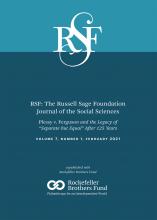Research Article
Open Access
Segregated Spaces and Separated Races: The Relationship Between State-Sanctioned Violence, Place, and Black Identity
Tia Sherèe Gaynor, Seong C. Kang, Brian N. Williams
RSF: The Russell Sage Foundation Journal of the Social Sciences February 2021, 7 (1) 50-66; DOI: https://doi.org/10.7758/RSF.2021.7.1.04
Tia Sherèe Gaynor
aAssistant professor of political science and founding director of the Center for Truth, Racial Healing, and Transformation at the University of Cincinnati, United States
Seong C. Kang
bAssistant professor at the Department of Government at New Mexico State University, United States
Brian N. Williams
cAssociate professor of public policy in the Frank Batten School of Leadership and Public Policy at the University of Virginia, United States

References
- ↵
- Alexander, Michelle
- ↵
- Anderson, Elijah
- ↵
- ↵
- ↵
- ↵
- Barak, Gregg,
- Jeanne M. Flavin, and
- Paul S. Leighton
- ↵
- Bass, Sandra
- ↵
- Beck, E. M., and
- Stewart E. Tolnay
- ↵
- Becker, Howard S
- ↵
- Black, Donald
- ↵
- ↵
- Brewer, Rose M., and
- Nancy A. Heitzeg
- ↵
- Byrne, Denis R
- ↵
- Byrne, Denis R
- ↵
- Carbado, Devon W
- ↵
- Close, Billy
- ↵
- Cox, Oliver Cromwell
- ↵
- Culver, Leigh
- ↵
- ↵
- Ellison, Ralph
- ↵
- Felson, Marcus, and
- Mary A. Eckert
- ↵
- Fischer-Baum, Reuben, and
- Al Johri
- ↵
- Gabbidon, Shaun
- ↵
- Goffman, Erving
- ↵
- Goldsmith, William, and
- Edward Blakely
- ↵
- Gross, Samuel R., and
- Robert Mauro
- ↵
- Hawkins, Holmer, and
- Richard Thomas
- ↵
- Henry, A’Lelia Robinson
- ↵
- Hsiao, Cheng
- ↵
- Hutchison, Harry G
- ↵
- Johnson, Norman J., and
- James H. Svara
- ↵
- Kendi, Ibram X
- Leadership Conference on Civil and Human Rights
- ↵
- Lipsitz, George
- ↵
- Lombroso, Cesare
- ↵
- Loury, Glenn
- ↵
- Mapping Police Violence
- ↵
- Marable, Manning
- ↵
- Massey, Douglas S., and
- Nancy A. Denton
- ↵
- Morris, Lorenzo
- ↵
- Myrdal, Gunnar
- ↵
- Nicholson-Crotty, Sean,
- Jill Nicholson-Crotty, and
- Sergio Fernandez
- ↵
- Osypuk, Theresa L.,
- Sandro Galea,
- Nancy McArdle, and
- Dolores Acevedo-Garcia
- ↵
- Ouimet, Marc, and
- Paul-Philippe Pare
- ↵
- ↵
- Pare, Paul-Philippe,
- Richard B. Felson, and
- Marc Ouimet
- ↵
- ↵
- ↵
- President’s Task Force on 21st Century Policing
- ↵
- Rice, Roger L
- ↵
- Rothstein, Richard
- ↵
- Russell, Katheryn
- ↵
- Sampson, Robert J.,
- Stephen W. Raudenbush, and
- Felton Earls
- ↵
- ↵
- Skolnick, Jerome H
- ↵
- Smith, Brad W
- ↵
- Tolnay, Stewart E., and
- E. M. Beck
- U.S. Census Bureau
- ↵
- U.S. Supreme Court
- ↵
- Van Evrie, John H
- ↵
- Ward, Geoff K
- ↵
- Ware, Leland
- ↵
- ↵
- Websdale, Neil
- ↵
- West, Cornel
- ↵
- ↵
- Weitzer, Ronald,
- Steven A. Tuch, and
- Wesley G. Skogan
- ↵
- Williams, Brian N.,
- Billy R. Close, and
- Seong C. Kang
- ↵
- Williams, Brian N
- ↵
- Zimring, Franklin E
- ↵
In this issue
Segregated Spaces and Separated Races: The Relationship Between State-Sanctioned Violence, Place, and Black Identity
Tia Sherèe Gaynor, Seong C. Kang, Brian N. Williams
RSF: The Russell Sage Foundation Journal of the Social Sciences Feb 2021, 7 (1) 50-66; DOI: 10.7758/RSF.2021.7.1.04
Jump to section
Related Articles
- No related articles found.
Cited By...
- No citing articles found.





